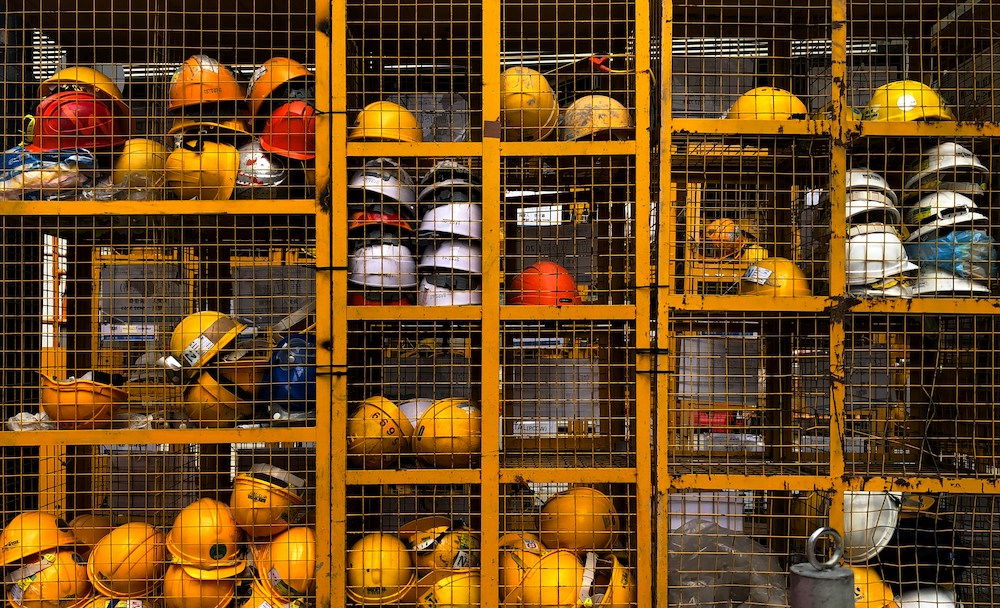A productive manufacturing facility is also a safe one. When pathways are clear, equipment is properly maintained, and materials are well-organized, both your people and your products can flow freely and without incident. Below are some manufacturing facility safety tips that can make your operation more productive as well as safe.
Provide all necessary PPE
Under Occupational Safety and Health Administration (OSHA) regulations, employers must provide workers with PPE (Personal Protective Equipment) whenever they are working in a potentially hazardous situation. Standard PPE includes earplugs, safety glasses, gloves, and breathing masks. In certain circumstances, your workers may also require hard hats or even hazmat suits.
While you are legally required to provide PPE, you can go one further by making it easily accessible and available in your facility. An earplug dispenser, for example, can make it easy for for employees to grab what they need at the start of each shift. While PPE costs can be expensive, they are nothing compared to the cost of a workplace accident or a lawsuit—so don’t cut corners on this valuable necessity.
Minimize the risks of slips and falls
A hefty percentage of workplace accidents in the manufacturing sector are due to slips and falls. You can minimize the chance of an incident occurring by:
- Ensuring each employee is wearing slip-proof shoes at every shift. If an employee does not have the correct footwear, do not allow that employee to work. Make sure all employees know that safety regulations will be enforced.
- Keeping aisles and walkways clear and clutter-free. Investing in bins and shelving can go a long way towards workplace safety, and make your production more efficient to boot.
- Installing anti-slip floor tape in high-traffic areas. Safety-Walk™, for instance, uses coarse mineral particles to add traction and slip resistance to your floors.
- You can also add vinyl safety tape (i.e. black-and-white striped tape) to low-visibility areas. If you can’t decide between anti-slip tape and safety tape, some products combine the two. Scheduling a monthly “floor check-up” in which you inspect the floor for loose boards, holes, or protruding nails.
Prevent lifting & back injuries
Back injuries are another common risk for those working in the manufacturing sector. You can help prevent them by training your team members in proper lifting protocol. OSHA provides guidelines on safe lifting techniques which you can teach to your team. This is another instance wherein enforcement is key—if you or a supervisor ever sees employees lifting with their backs, make sure to address the issue promptly.
You might also consider investing in mechanical aids that make lifting easier. On the less costly end, a back support brace is a simple yet effective way to help employees remember to pay attention to their posture. If your employees must regularly handle heavy loads, invest in wheelbarrows, hand trucks, pallet jacks, and forklifts.
Prevent falls from 4 feet & above
This one won’t apply to every manufacturing facility, but as falls tend to result in the worst injuries, it is worth addressing. OSHA requires that fall protection be provided at elevations of four feet in general industry workplaces; five feet in shipyards; six feet in the construction industry; and eight feet in longshoring operations. What constitutes adequate fall protection will vary from industry to industry, but it usually includes a positioning belt or harness and some type of lanyard. Some work areas will require more sophisticated fall arrest systems, as well as guardrails, scaffolding, and ladders.
Make sure that you have fully investigated and understood the safety requirements that are specific to your industry, and again, invest in everything and anything you might need to guarantee your workers’ (and your business’) health. Make sure that all employees are trained in fall protection systems and safety equipment, and inspect all equipment regularly to ensure it is in good working order.
Invest in awareness & training
Having emergency plans, systems, and equipment are all important steps in protecting your facility. However, they will all be useless if employees don’t know where, or what they are. Therefore, make sure that every employee, right down to administrative assistants, know where to find fire extinguishers and first aid kids. Team members should also know what to do if someone is injured, and where to go in an emergency.
Finally, try to maintain open lines of communication between yourself and your employees. Let team members know that it is always okay to share any challenges and potential dangers they encounter. Fixing problems promptly will let all employees know that their feedback will be heard and addressed. This, in turn, will make them more likely to approach you about issues in the future.
Protect your business with manufacturing facility safety
In the fast-paced manufacturing sector, it’s easy for anyone to let their guard down for a second or two. Investing in the equipment, training, and machinery you need will help ensure that your employees stay safe. It will also ensure that the business you worked so hard to build continues to flourish.
If you live near Richmond, VA and are in need of workplace safety equipment, SSI Packaging is here to help. Please take a moment to check out our product catalog. Just let us know if you can’t find what you need—we may be able to procure it for you. Want more manufacturing facility safety tips? Be sure to check out our blog!

